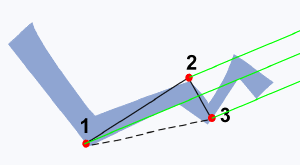![]()
Charting Andrews Pitchfork:
 |
Resizing the Andrews Pitchfork Drawing:
- Select the drawing by clicking on it.
Note: The drawing is selected when boxes appear on the corners.- Click on one of the boxes to drag the select point and release the mouse button.
Moving the Andrews Pitchfork Drawing:
Select the drawing by clicking on it continue holding down the mouse button, drag to the new location and release the mouse button.
Deleting the Andrews Pitchfork Drawing:
Select the drawing by clicking on it and press the delete key on your keyboard to remove.
Changing the Properties of a Andrews Pitchfork Drawing:
- Right-Click on the drawing to view the properties menu. (see below)
- Properties that can be changed are:
- Foreground: Changes the line color of the Andrews Pitchfork.
- Line Thickness: Changes the thickness of the Andrews Pitchfork.
Choose values from 1-6.- Line Style: Changes The line style of the Andrews Pitchfork Line. Choose from solid, dashed, dotted and more.
- Send to back: Changes the layer of the tool. This option is used when more than one tool is in the same area of the chart. Click on Send to Back when you need to access a tool under the Andrews Pitchfork Drawing.
Indicator Type: Non-Indicator
Introduction:
Dr. Alan Andrews developed a channel technique to show areas of support and
resistance from a baseline. This use of a median line is the key to using the
Andrews Pitchfork. Buying near lows and selling near highs that are identified
by the “tines” of the pitchfork. The basic premise is to trade the channel from
one level of support or resistance to the next.
Interpretation:
The first element to draw the Andrews Pitchfork is the centerline. The middle
tine or median line begins at the most recent contract low or high. To plot the
direction of this point we must attain the other two points. The top tine is
determined by looking at the highest move made from the origin of the contract
low or high. The next point is found by looking at the retracement of that move.
For example, a contract begins at point A rallies to point B, and sells off from
B to point C. A line is draw from point B and C, and then the line originating
at point A splits those two lines equally.
This pitchfork shows continuing points of support and resistance. The general
use of this tool is to sell when the market rises to line B, and take profits
once prices reach line A the middle tine. Also to buy when prices dip to line C
and take profits when they reach line A. This series of movements within the
pitchfork affords traders the opportunity to trade a channel system within a
trending market.
Example:
